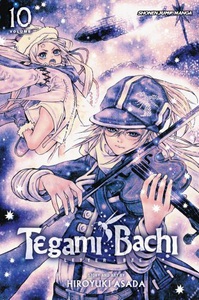Review
by Rebecca Silverman,Tegami Bachi: Letter Bee
GN 10
| Synopsis: |  |
||
Lag has been overworking his body and heart in his efforts to get the mail in the Dead Letter Office delivered. When he falls ill, Aria takes over his work, borrowing Niche to be her temporary dingo. But more is going on than meets the eye when Lag's illness takes a turn for the weird and one of the letters Aria must deliver belongs to a man who survived the airship crash twelve years ago... |
|||
| Review: | |||
Tegami Bachi's plot is starting to move. Not that the previous nine volumes have been dragging or ever felt as though they had no point; it is just that now with the tenth volume, Hiroyuki Asada appears to have reached the place he was aiming for. Threads start to come together as Lag and Aria both contribute to our knowledge of what Reverse is really trying to do in very different ways. The volume picks up where its predecessor left off, with Lag and Aria demoted to the Dead Letter Office. Since Lag's shindan can reveal other people's hearts, he's been making great progress in clearing the backlog, but this is not without its price. After exhausting his heart, Lag falls ill. The unsympathetic government men insist that he get right back to work, but Aria, who has been doing administrative tasks alongside Lag, offers to take his place and deliver the mail. Since her beloved dingo from her own Letter Bee days is too old to go with, Lag forces Niche (and Steak) to go along to protect her. Asada deftly shows us just how long it has been since Aria was on delivery duty by a scene that anyone who has an aversion to throwing out clothes will recognize – she struggles to get into her old uniform. While it does fit, her words and the images that accompany them are a dose of realism in a fantasy (or is it science fiction?) story – here too, people put their pants on one leg at a time, and sometimes strain to get the damn things over their hips. While Lag languishes in Dr. Thunderland's lab beside an unconscious Gauche, Aria and Niche set out to deliver a letter to one of the six survivors of the airship that crashed twelve years earlier during an event called “the flicker.” We have read about this event before, mostly in connection with Gauche's heart and Lag's mother, but this is the first time Asada has really given us any depth in his coverage of it. Now we learn just why the ship was sent out in the first place, who was on it, and what caused it to crash. Light is also shed upon some of Reverse's comments from the last couple of books – in the end of volume nine and the start of volume ten, a comment is made about the make-up of Amberground's artificial sun. What the crash survivor tells Aria gives those remarks an ominous edge, and suddenly we find ourselves wondering just who the real bad guys are. The side effect of all of this exposition is that the tone of Tegami Bachi changes fairly significantly from the softly emotional story it has been for roughly eight and a half volumes into something more charged with peril. While there are still plenty of heart-wrenching moments involving flashbacks and Gauche's relationships with Sylvette and Lag, the overall tenor of the tale has switched to something more ominous. Interestingly enough, this leads to a totally new interpretation of the series' artwork. Where before the black and gray heavy images seemed to lend the story a soft, fuzzy feeling, now that use of dark space feels more ominous, like a world on the edge rather than one whose sharp corners are muffled by cotton batting. An examination of earlier volumes does not show any significant differences in Asada's artwork apart from the natural evolution of his style, so we are forced to conclude that we are simply being given different hints about how to read the pictures. It is a testament to Asada's storytelling that he is able to do this. Of course the usual artistic quibbles are present here – gray and black heavy pages sometimes make details difficult to see, and Asada's apparent dislike of placing pants on the waist really detracts when Aria wears the Letter Bee uniform. He also has trouble drawing the groin area on both males and females with the women giving him more issues – poor Aria looks incredibly uncomfortable in more than a few pictures. Although the series is still ongoing in Japan, one gets the feeling that with volume ten it has reached the place it was aiming for. With Gauche back in the beehive (for now, at least), the truth about the airship crash revealed, and Reverse's motivations suddenly making a whole lot more sense, it looks like the stakes have gone up and the story's momentum is on the rise. The dream may have become a nightmare, but Asada's strange and fascinating tale remains one that is worth paying attention to. |
| Grade: | |||
|
Overall : B+
Story : A-
Art : B+
+ Important plot revealed, the artwork suddenly looks ominous thanks to the storytelling. A nice combination of the earlier melancholy dream feel and the new dangerous one. |
|||
| discuss this in the forum (1 post) | | |||
| Production Info: | ||
|
Full encyclopedia details about Release information about |
||